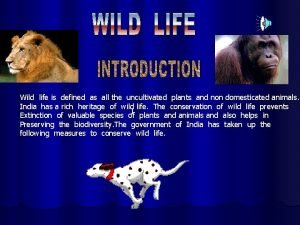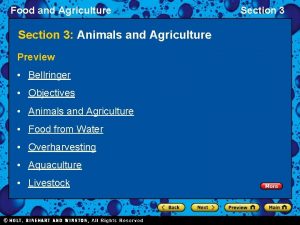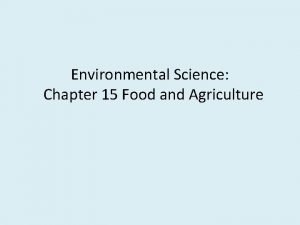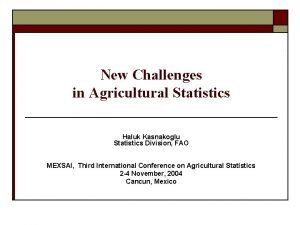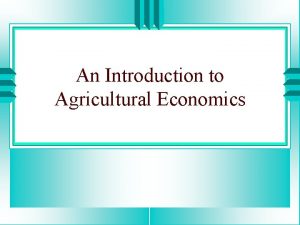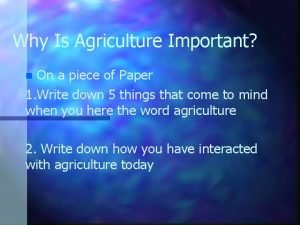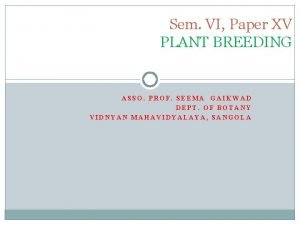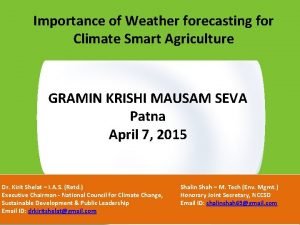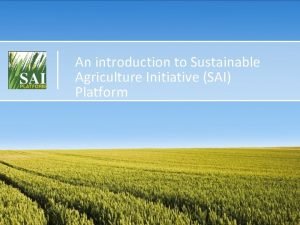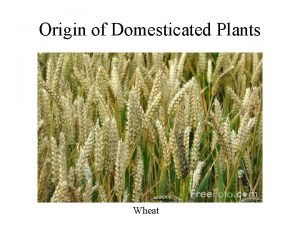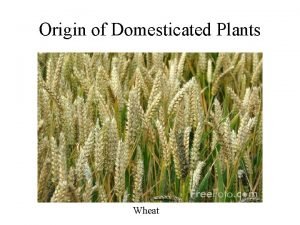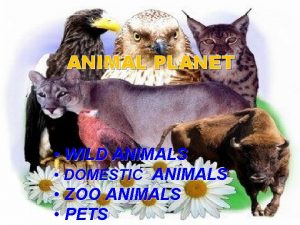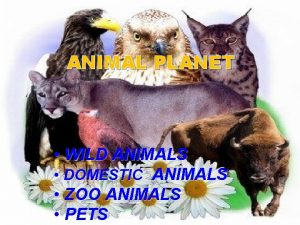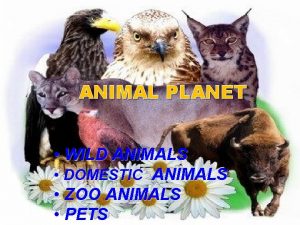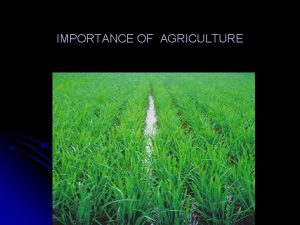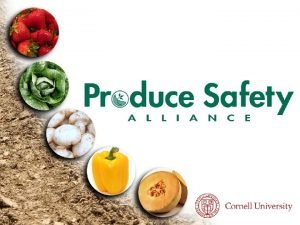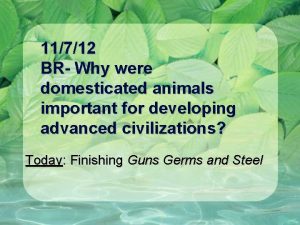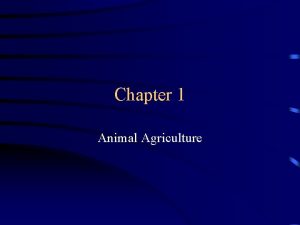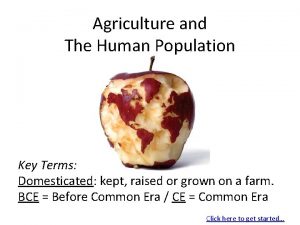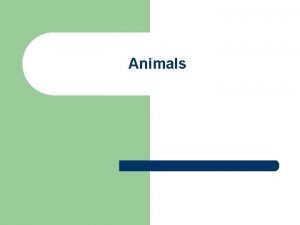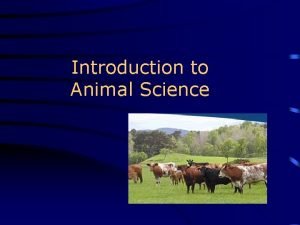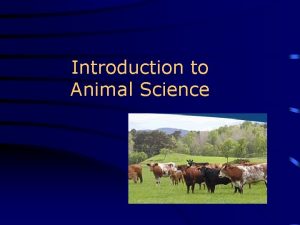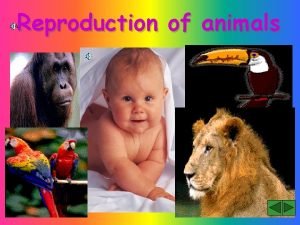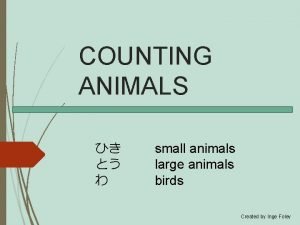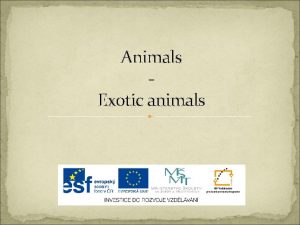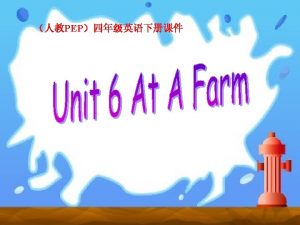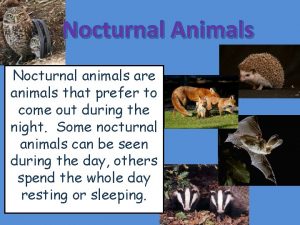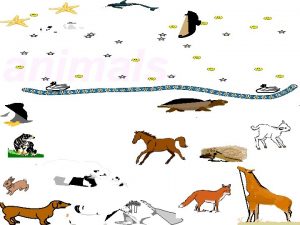Introduction To Animal Agriculture Importance of Domesticated Animals

























- Slides: 25

Introduction To Animal Agriculture

Importance of Domesticated Animals • Animal domestication • • Animal/human relationship • What do animals provide? • • What do humans provide? •

Importance of Domesticated Animals • Every country in the world uses domestic livestock as a source of: • Food • • by-products used for: • consumer goods and animal feeds • Draft power • Manure for fuel and fertilizer • •

Domesticated Animals


Food Selection vs Food Supply • What determines how much animal protein a population consumes? • • Animal protein availability is closely related to the economic status of the people and their agricultural technology • This is true: • When discussing countries • When discussing populations within country • Developing regions (SE Asia, Africa, etc) diets are primarily of plant origin

Food Selection vs Food Supply • Per capita calorie and protein supply • An index of food availability • Large differences exist between • developed countries • developing countries




Trends Related To Percentage of The Population Involved in Agriculture • Countries with a small percentage of their population involved in agriculture: • • Farm mechanization allows: • Increased food production • • Production of goods and services Thus increasing the standard of living in the country

U. S. Agricultural Production • Agricultural productivity doubled from 1820 to 1920 • 100 years • 1920 to 1950 it doubled again • 30 years • 1950 -1965 it doubled again • 15 years • 1965 -1975 it doubled again • 10 years • After World War II • Productivity increased 5 fold in only 30 years • Abundant production of feed grains • Increased livestock production • Lower cost of animal products for the human population


U. S. Food Expenditures • In the U. S. : • Releasing people from producing their own food has allowed them to increase their per capita income • • U. S. consumers allocate a smaller percentage of their disposable income to food than do people in other countries • Has food prices inflated at the same rate as most other goods and services? What does the mean to the US Rancher & Farmer?



Importance of Meat as a Food Source • Amino Acid pattern • Amino acids • • A, B, C analogy • Scenario 1 • 100 A, 100 B, 100 C • Scenario 2 • 100 A, 50 B, 25 C • Pattern of amino acids in meat more closely resembles that of human muscle than does the pattern in plant protein • Vitamin B 12 • •

Human/Animal Food Competition • World Agricultural land • About 2/3 is pasture or rangeland • 60% of this land is not suitable for row cropping • This pasture can be used to grow forages that can be consumed by ruminants • Convert to human usable, high quality protein • US Agricultural land • 44% of total land area used for grazing • Only supports 40% of cattle population • Where are the remainder • Could support much more if managed intensively • Ruminants make use of forages that would otherwise be useless to make high quality animal protein for human consumption


Human/Animal Food Competition • World Population Continues to Increase • Many are concerned about animal/human food competition • • More acres of cropland are required to feed each person when diets high in animal products are consumed • The debate over this issue will only increase Figure 1. 6 Past, present, and projected world population. Source: U. S. Census Bureau.


Increased Efficiency • Ability to convert input to product • What led to the increases • Research • Current trends are to decrease government spending on research

What Other Contributions Do Animals Make to Society • Products • Wool, mohair, hides, etc. • Synthetics have decreased demand • Animal waste used as fertilizers • $1 billion per year in value • Tallow • Gelatin

What Other Contributions Do Animals Make to Society • Draft Power • In developing countries, animals provide virtually all of the power for agriculture • 20% of the worlds population depend on animals to move goods • Developing countries • 52% of draft power from animals • 26% from humans

What Other Contributions Do Animals Make to Society • Recreation
 Non domesticated animals and uncultivated plant life
Non domesticated animals and uncultivated plant life Asian massage mongol
Asian massage mongol Simile comparing a tree with a domesticated animal
Simile comparing a tree with a domesticated animal Chapter 24 section 1 animal characteristics
Chapter 24 section 1 animal characteristics Section 3 animals and agriculture
Section 3 animals and agriculture Active reading feeding the world
Active reading feeding the world 10 importance of agriculture
10 importance of agriculture 10 importance of agriculture
10 importance of agriculture Importance of agriculture economic
Importance of agriculture economic What is the importance of agriculture
What is the importance of agriculture A local tractor dealership is best described as an
A local tractor dealership is best described as an Definition of plant breeding
Definition of plant breeding Contingent crop planning slideshare
Contingent crop planning slideshare Https://a-z-animals.com/animals/
Https://a-z-animals.com/animals/ Is a horse a producer consumer or decomposer
Is a horse a producer consumer or decomposer G h patel college of engineering and technology
G h patel college of engineering and technology Animals that eat both plants and animals
Animals that eat both plants and animals Importance of kindness to animals
Importance of kindness to animals Red algae economic importance
Red algae economic importance Introduction of sustainable agriculture
Introduction of sustainable agriculture Introduction of agriculture
Introduction of agriculture Introduction to smart agriculture
Introduction to smart agriculture Sustainable agriculture definition
Sustainable agriculture definition Lesson 3 animal body plans 2
Lesson 3 animal body plans 2 Lesson 2: animal body plans: 1 biology b unit 3: animals
Lesson 2: animal body plans: 1 biology b unit 3: animals Aare tool
Aare tool
